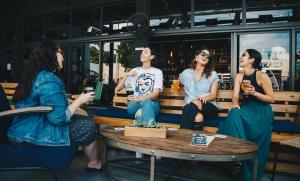Psychosocial processes through Graffiti
We know that the context conditions, but the individual in turn is a change agent of the environment. This is one of many reasons why psychology has to be especially sensitive to the psychobiological processes of people in order to understand them and establish effective strategies to favor these processes of change and reciprocal learning between professionals and participants.
In the case of participatory murals through the graffiti technique in different educational settings, in In this non-formal case, we see how a strategy duly adapted to the context is a very useful tool. in order to detect possible problems and transform the perception of the reality of the participants.
Why the graffiti?
We call participatory murals through the graffiti technique because graffiti itself is given with other pretexts, but at the same time it is a tool through which it is possible to promote the feeling of belonging to a team, and at the same time bring out the individualizing elements of each subject. A visual and striking technique like this is transformative of the environment, and if it is done through teamwork, it creates endless creative possibilities in the process of making a mural.
Graffiti is framed within the movement Hip hop. In May 2001 a document called “Hip Hop Declaration of Peace"In which the philosophical bases of the movement were established by leading figures in the field. These articles are in tune with educational practices that are considered valid for social transformation and development. development of the self, therefore it can be considered a decalogue to understand what theoretical framework encompasses the practice of this discipline of Hip Hop.
Theories of development: Piaget and Vygotsky
According to the theories of Jean piaget Y Lev Vygotsky we can observe how the environment and genetics interact in the creation of identity and cognitive schemas. Taking into account the main criticisms of each model, in this case, the proximal development theory, since we do not deal with the same profiles depending on the context, for example a CRAE and a neighborhood house. The stages of development must be taken into account, but the inherent differences in each environment mean that there may be a gap between the ages proposed by Piaget.
A point to take into account for the exercise of psychology are the cross-cultural competences, since in a context of globalization like the current one, we can deal with people of different beliefs and cultures. The adequacy of technique and treatment to the principles of each culture is essential for the creation of positive links between psychologists and participants (Wen-Shing, 2004).
Individual differences and the creation of contexts felt as their own
The use that is given to the environment is not the same in a CRAE that in a neighborhood houseStarting from that base, it is necessary to detect which is the emotional connection to the space and between the participants to be able to generate strategies that can transform negative connotations into a range of possibilities with a focus positive. These relationships are observed in the course of the activity, in how they are treated and how they interact with each other. To do this, a free space is created to express ideas and act naturally under the premise of respect. We must not forget the previous decalogue to give meaning to the activity and the real background it has.
The exposition of ideas and the consensus serve to decide what will be the elements that will be part of the mural and its interpretation. In this process, the subjective concepts of perception come to light. beauty in the art, but the main objective is not to create works that will be judged later, but to generate a graphic expression of the psychobiological and emotional processes of the participants. Foster the ability to abstraction it can be a positive factor when interpreting a drawing, a detail, a set of colors... since, as in the principles of the artetherapy, the meaning is not only in the symbolism and in what is perceptible at first sight.
Once the sketch of the mural has been created through the opinions of the participants, the creation of a “crew", Which in the context of graffiti means:" organized group that works to achieve collective goals. " This serves to materialize the feeling of belonging to a group through the combination of words and numbers that give meaning to the because they are together and work as a team.
To finalize the process of creating a participatory mural you have to capture it through the technique of graffiti in a Wall or a ceiling. The objective of creating this graphic expression is to transform the context based on the differences individual participants in each setting, and that in turn, this transformation positively influences individuals. The results pictorial and interpretive will be different in each setting, but the point of Union in each context, it is the internalization of an experience and the processes lived in it.
Conclusions
The creation of creative contexts in which the dynamics are adapted to the participants, in a way in which they themselves set the pace and can be free expressing yourself, it is a way to minimize the Pygmalion effect associated with conventional educational practices and the paradigm from which it starts when “educating”. The processes of learning They are reciprocal, and an open position on the part of the professionals helps to this.
Since the different realities from which the participants come according to their environment can create cognitive dissonances to the professionals between the expectations and the processes experienced in the course of the activity. It must be taken into account that the theories that are the object of study in Psychology and in other disciplines were generated in a specific context, that context can be transformed, and we must do it with it.
Bibliographic references:
- Wen-Shing, T. (2004). Culture and psychotherapy: Asian perspectives. Journal of Mental Health, 13(2), 151-161.


